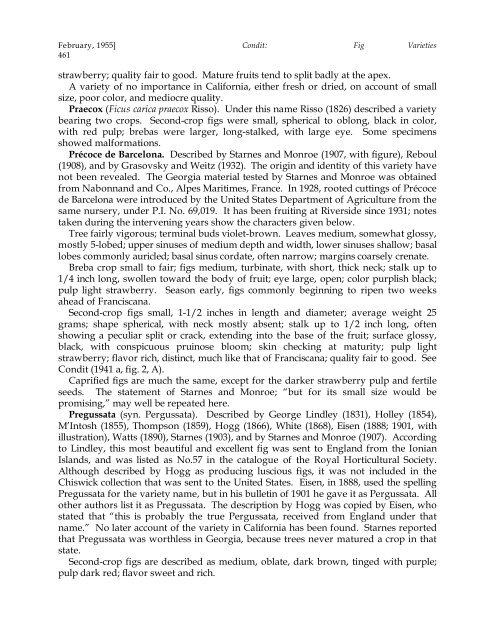Fig Varieties: A Monograph - uri=ucce.ucdavis
Fig Varieties: A Monograph - uri=ucce.ucdavis
Fig Varieties: A Monograph - uri=ucce.ucdavis
Create successful ePaper yourself
Turn your PDF publications into a flip-book with our unique Google optimized e-Paper software.
February, 1955] Condit: <strong>Fig</strong> <strong>Varieties</strong><br />
461<br />
strawberry; quality fair to good. Mature fruits tend to split badly at the apex.<br />
A variety of no importance in California, either fresh or dried, on account of small<br />
size, poor color, and mediocre quality.<br />
Praecox (Ficus carica praecox Risso). Under this name Risso (1826) described a variety<br />
bearing two crops. Second-crop figs were small, spherical to oblong, black in color,<br />
with red pulp; brebas were larger, long-stalked, with large eye. Some specimens<br />
showed malformations.<br />
Précoce de Barcelona. Described by Starnes and Monroe (1907, with figure), Reboul<br />
(1908), and by Grasovsky and Weitz (1932). The origin and identity of this variety have<br />
not been revealed. The Georgia material tested by Starnes and Monroe was obtained<br />
from Nabonnand and Co., Alpes Maritimes, France. In 1928, rooted cuttings of Précoce<br />
de Barcelona were introduced by the United States Department of Agriculture from the<br />
same nursery, under P.I. No. 69,019. It has been fruiting at Riverside since 1931; notes<br />
taken during the intervening years show the characters given below.<br />
Tree fairly vigorous; terminal buds violet-brown. Leaves medium, somewhat glossy,<br />
mostly 5-lobed; upper sinuses of medium depth and width, lower sinuses shallow; basal<br />
lobes commonly auricled; basal sinus cordate, often narrow; margins coarsely crenate.<br />
Breba crop small to fair; figs medium, turbinate, with short, thick neck; stalk up to<br />
1/4 inch long, swollen toward the body of fruit; eye large, open; color purplish black;<br />
pulp light strawberry. Season early, figs commonly beginning to ripen two weeks<br />
ahead of Franciscana.<br />
Second-crop figs small, 1-1/2 inches in length and diameter; average weight 25<br />
grams; shape spherical, with neck mostly absent; stalk up to 1/2 inch long, often<br />
showing a peculiar split or crack, extending into the base of the fruit; surface glossy,<br />
black, with conspicuous pruinose bloom; skin checking at maturity; pulp light<br />
strawberry; flavor rich, distinct, much like that of Franciscana; quality fair to good. See<br />
Condit (1941 a, fig. 2, A).<br />
Caprified figs are much the same, except for the darker strawberry pulp and fertile<br />
seeds. The statement of Starnes and Monroe; “but for its small size would be<br />
promising,” may well be repeated here.<br />
Pregussata (syn. Pergussata). Described by George Lindley (1831), Holley (1854),<br />
M’Intosh (1855), Thompson (1859), Hogg (1866), White (1868), Eisen (1888; 1901, with<br />
illustration), Watts (1890), Starnes (1903), and by Starnes and Monroe (1907). According<br />
to Lindley, this most beautiful and excellent fig was sent to England from the Ionian<br />
Islands, and was listed as No.57 in the catalogue of the Royal Horticultural Society.<br />
Although described by Hogg as producing luscious figs, it was not included in the<br />
Chiswick collection that was sent to the United States. Eisen, in 1888, used the spelling<br />
Pregussata for the variety name, but in his bulletin of 1901 he gave it as Pergussata. All<br />
other authors list it as Pregussata. The description by Hogg was copied by Eisen, who<br />
stated that “this is probably the true Pergussata, received from England under that<br />
name.” No later account of the variety in California has been found. Starnes reported<br />
that Pregussata was worthless in Georgia, because trees never matured a crop in that<br />
state.<br />
Second-crop figs are described as medium, oblate, dark brown, tinged with purple;<br />
pulp dark red; flavor sweet and rich.
















![Fig Trees in North Carolina [Archive] - IDigMyGarden ... - Figs 4 Fun](https://img.yumpu.com/26905320/1/190x245/fig-trees-in-north-carolina-archive-idigmygarden-figs-4-fun.jpg?quality=85)